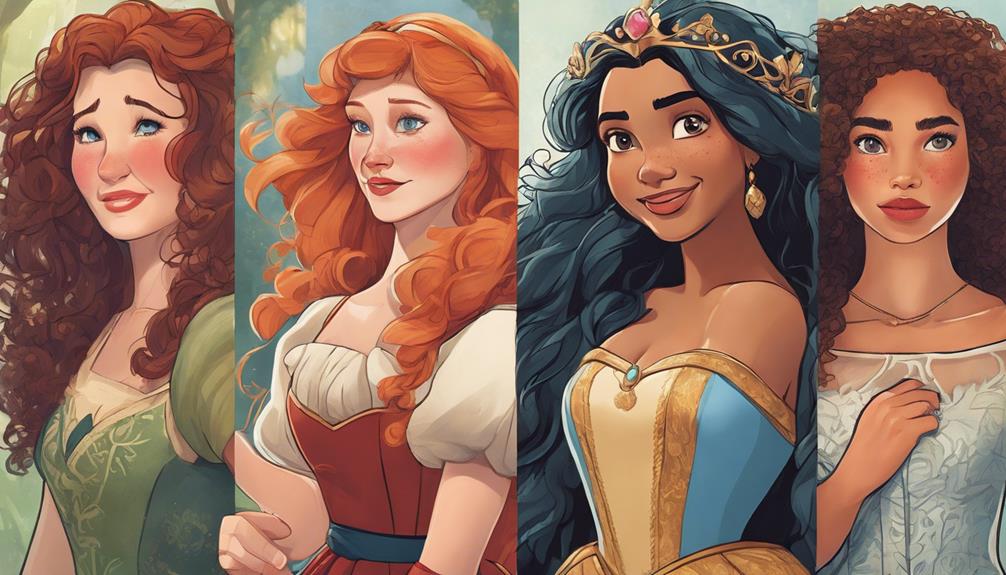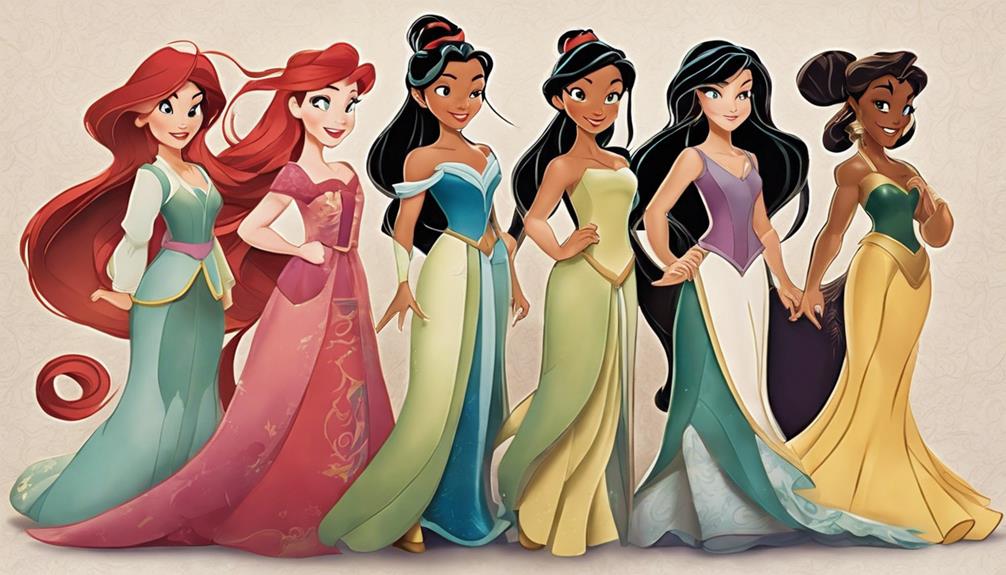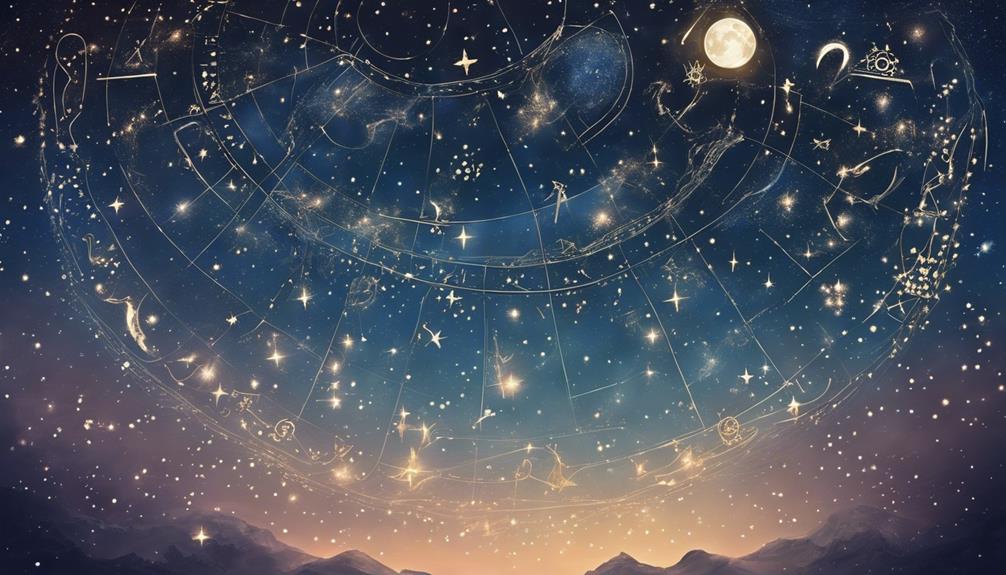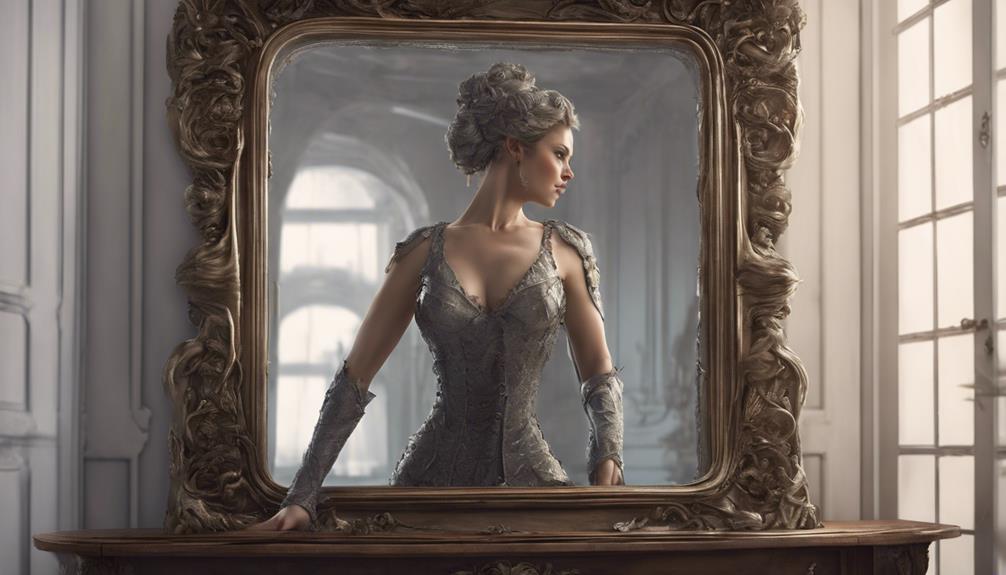While we delve into the complex universe of personality types via Disney characters, we encounter a fascinating idea that each princess reflects a distinct Myers-Briggs personality profile.
Whether it's the adventurous and independent spirit of Merida or the nurturing and empathetic nature of Cinderella, Disney's female characters offer a diverse array of personalities that resonate with audiences of all ages.
But what deeper insights lie behind these enchanting personas? The connections between character development and personality types in Disney films unveil a fascinating realm worth exploring further.
Key Takeaways
- Disney Princesses embody diverse Myers-Briggs types, showcasing a range of personalities.
- Female characters exemplify specific traits like kindness, determination, and compassion.
- Character alignment drives plot conflicts, revealing moral perspectives and nuanced relationships.
- Disney characters promote cultural representation, fostering inclusivity and appreciation for diverse backgrounds.
Disney Princesses as Myers-Briggs Types
In exploring the intersection of Disney princess characters with Myers-Briggs personality types, we uncover a fascinating correlation between beloved fictional figures and psychological archetypes. Belle, representing the INFP personality type, embodies traits of introversion, idealism, and compassion. Her love for books and her ability to see beyond appearances resonate strongly with the characteristics of an INFP.
Elsa, as an INFJ, showcases introversion, compassion, and vision, aligning with her complex and empathetic nature in 'Frozen.' Tiana, the ESTJ princess from 'The Princess and the Frog,' exudes practicality, determination, and a strong sense of duty, mirroring the traits of this personality type.
Cinderella, an ISFJ, reflects kindness, loyalty, and selflessness, evident in her caring and nurturing demeanor. Lastly, Rapunzel's ENFP personality shines through her outgoing, adventurous, and expressive nature in 'Tangled,' capturing the essence of this personality type's traits within the realm of Disney princesses.
Female Disney Characters and Personality Traits

Examining the intricate connection between female Disney characters and their distinctive personality traits reveals a rich tapestry of psychological depth and character development. Elsa, representing the INTJ personality type, showcases strategic planning and a focus on power and control.
Snow White embodies the ISFJ traits of kindness, compassion, and duty. Tiana from The Princess and the Frog exemplifies ESTJ characteristics like practicality, detail-orientation, and determination. Cinderella also aligns with ISFJ, displaying kindness, loyalty, and a focus on relationships.
Queen Elinor from Brave mirrors the ISTJ personality, known for practicality, detail-orientation, and a reverence for tradition. Each of these female Disney characters offers a nuanced portrayal of diverse personality types, bringing depth and complexity to their stories.
Through their actions and decisions, they embody a range of traits that resonate with audiences, showcasing the multifaceted nature of human personalities in the magical world of Disney.
Character Alignment in Disney Narratives
Character alignment in Disney narratives illuminates the moral and ethical compass guiding the actions and decisions of each character within the intricate web of storytelling.
Key Points:
- Defining Perspectives:
Character alignment helps classify Disney characters as either good, evil, or neutral based on their moral and ethical perspectives, shaping their roles in the narrative.
- Motivations and Relationships:
Understanding character alignment provides insights into the motivations that drive characters and the dynamics of their relationships with others in the story.
- Conflict and Resolution:
The alignment of characters often leads to conflicts that drive the plot forward, showcasing the complexities of their decisions and the resolutions they seek.
Disney narratives use character alignment to create a rich tapestry of personalities that interact with each other in compelling ways. Whether heroes, villains, or those in between, the moral and ethical choices characters make influence not only their individual journeys but also the overarching themes of the stories they inhabit.
Personality Development in Disney Films

Exploring the intricate layers of personality development within Disney films reveals a nuanced tapestry of character growth and evolution. Disney films often align characters with specific Myers-Briggs personality types, allowing viewers to delve into the motivations and behaviors driving their actions.
Each female character in Disney represents a unique personality type, showcasing a range of traits and characteristics that contribute to their individual growth and self-discovery throughout the storylines. By analyzing the personality development of these characters, audiences gain a deeper understanding of how they evolve over time, navigating challenges and experiences that shape their personalities.
From the determined and independent Princess Merida in 'Brave' to the compassionate and adventurous Moana in her self-titled film, Disney characters embody a spectrum of personality traits that lead to profound moments of self-realization and transformation. Through their journeys of self-discovery, these characters illustrate the complexities of personality evolution in a way that resonates with viewers of all ages.
Disney Characters and Cultural Representation
Moving from the exploration of personality development in Disney films, we shift our focus to the significant role Disney characters play in cultural representation, highlighting diverse personalities and traits. Disney characters serve as mirrors reflecting the rich tapestry of human experiences across various cultures. Through their depictions, Disney promotes inclusivity by showcasing characters from different backgrounds, offering a platform for individuals to see themselves represented on screen.
- Relatable Inspirations: Disney characters embody a spectrum of cultural values and traditions, making them relatable and inspirational figures for audiences worldwide.
- Promoting Diversity: By portraying characters with diverse backgrounds, Disney fosters awareness and appreciation for different perspectives, enriching the viewer's understanding of global cultures.
- Cultural Awareness: Through storytelling, Disney characters bring attention to unique cultural identities, encouraging viewers to embrace and celebrate the richness of diversity portrayed on screen.
In essence, Disney characters transcend entertainment, becoming ambassadors of cultural awareness and appreciation, fostering a more inclusive and understanding society.
Frequently Asked Questions
Which Disney Princess Is an Infj?
We believe the Disney Princess that embodies the INFJ personality type is Elsa from Frozen. Her introverted, compassionate, and intuitive nature aligns perfectly with INFJ traits.
Elsa's leadership qualities, ability to comfort others, and sense of purpose mirror the characteristics of an INFJ individual.
She exemplifies the INFJ ability to see hidden meanings, guide others, and use her powers for the greater good, making her a fitting representation of the INFJ type.
What Mental Disorder Does Rapunzel Represent?
We're diving into the world of Disney and mental health with Rapunzel from 'Tangled.'
This long-haired princess embodies Stockholm Syndrome, showcasing the complexities of trust and manipulation.
Her journey to break free from Mother Gothel's control symbolizes overcoming abusive relationships and reclaiming personal autonomy.
Through her struggles with self-worth and anxiety, Rapunzel's story sheds light on themes of healing and empowerment, resonating with those seeking liberation from psychological captivity.
What Does Each Disney Princess Represent?
When exploring each Disney princess, we uncover a rich tapestry of personality traits that align with specific Myers-Briggs types. From Belle's INFJ compassion to Elsa's INTJ intellect, these characters serve as archetypes embodying various psychological profiles.
Snow White's ISFJ practicality and Tiana's ISTJ attention to detail further showcase the diverse range of personalities represented in Disney's iconic female characters. Through these princesses, we see the multifaceted nature of human personalities mirrored in storytelling.
Which Disney Princess Is an Enfp?
We believe Rapunzel from 'Tangled' embodies the ENFP personality type. She exemplifies the outgoing, spontaneous, and expressive nature typical of ENFPs. Rapunzel's positive outlook, curiosity, and love for adventure align perfectly with ENFP traits.
Like many ENFPs, she's a creative problem solver who embraces new experiences. Rapunzel's intuition and passion for exploration make her a prime example of an ENFP Disney princess.
Conclusion
As we explore the intricate connections between Disney princesses and Myers-Briggs personality types, we uncover a world where imagination and psychology intertwine.
The diverse range of female characters in Disney films offers a mirror to our own personalities and behaviors, inviting us to reflect on the complexities of human nature.
Delving deeper into the realm of Disney reveals a rich tapestry of personality development and cultural representation, leaving us eager to unravel more layers of this enchanting storytelling universe.
Felicity, our Author, pens in-depth articles and guides that delve into the heart of personal discovery. Her narrative-driven approach weaves together theory, practice, and personal anecdotes, making the journey of self-exploration both relatable and inspiring. Felicity’s contributions help illuminate the path for those seeking a deeper understanding of themselves and their relationships.










